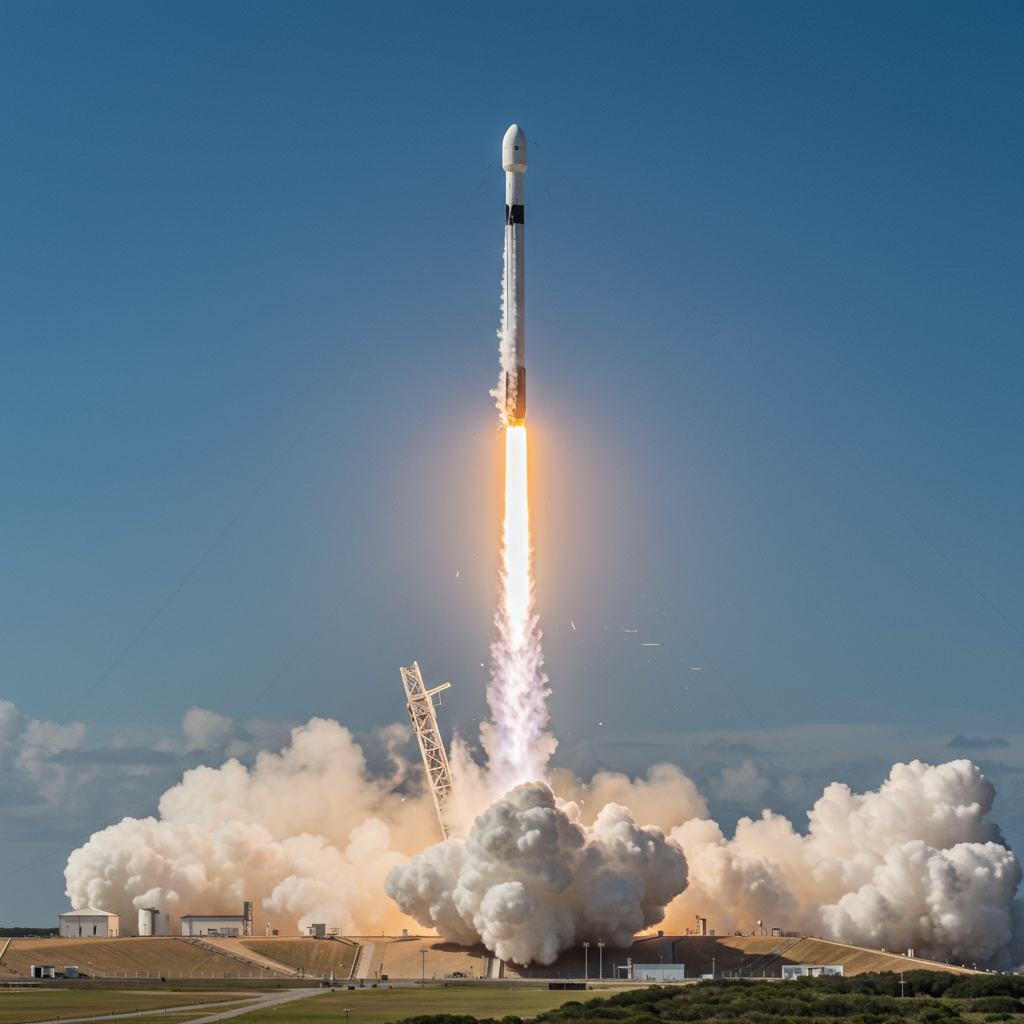A powerful new era for European Earth observation has officially begun. On Tuesday, July 1, 2025, a SpaceX Falcon 9 rocket soared from NASA’s historic launch Complex 39A at Kennedy Space Center in Florida, carrying two critical European satellites: the Meteosat Third Generation Sounder (MTG-S1) and the Copernicus sentinel-4 instrument. This mission marks a significant step forward in monitoring both weather phenomena and atmospheric composition over Europe and North Africa, promising unprecedented data for forecasters, researchers, and public health officials. The successful launch paves the way for greatly improved severe weather warnings and detailed insights into air quality.
Liftoff from the Space Coast
The launch occurred precisely at 5:04 p.m. EDT (2104 UTC) under clear Florida skies. The reliable Falcon 9 booster, tail number B1085, powered the mission. This flight was the ninth for this particular booster, highlighting SpaceX’s continued success in rocket reusability. Previous missions for B1085 include critical launches like NASA’s Crew-9 and Fram2, as well as Firefly Aerospace’s Blue Ghost Mission 1.
Just over eight minutes after liftoff, the first stage booster performed a flawless vertical landing. It touched down on the autonomous droneship ‘Just Read the Instructions’ stationed in the Atlantic Ocean. This successful recovery marked the 127th landing for that specific vessel and the 471st booster landing overall for SpaceX. The recovered booster is expected to be refurbished for future missions, further reducing the cost of access to space. The satellite payload continued its journey towards orbit atop the Falcon 9’s second stage.
Journey to Geostationary Orbit
Approximately 35 minutes after leaving the launch pad, the MTG-S1 satellite, with Sentinel-4 integrated, separated from the Falcon 9 upper stage. The satellite was placed into a geosynchronous transfer orbit (GTO). This is an initial, elliptical path around Earth that positions the satellite for its final destination. Over the next roughly 17 days, the satellite will perform maneuvers to reach its operational position.
The target destination is geostationary Earth orbit (GEO). This orbit is located about 36,000 kilometers (roughly 22,369 miles) above the equator. Satellites in geostationary orbit travel at the same speed as Earth rotates. This allows them to remain fixed over a specific geographical area. This stable vantage point is crucial for continuous monitoring of weather systems and atmospheric changes below.
MTG-S1: A New Dimension in Weather Observation
The primary passenger on this mission was the Meteosat Third Generation Sounder, designated MTG-S1. Developed by the European Organisation for the Exploration of Meteorological Satellites (EUMETSAT) in collaboration with the European Space Agency (ESA), this satellite is a game-changer for European weather forecasting. It is the second satellite launched in the ambitious six-satellite MTG constellation. This new generation is designed to operate as two interconnected trios of satellites: one sounder and two imagers.
MTG-S1 represents Europe’s first hyperspectral sounding instrument positioned in geostationary orbit. This advanced technology allows it to scan target areas with remarkable speed and detail. The satellite is designed to survey areas as frequently as every 15 minutes. Its core capability is providing detailed vertical profiles of atmospheric temperature and humidity. This data is critical for creating 3D maps of the atmosphere.
Enhanced Forecasting Capabilities
The information gathered by MTG-S1, particularly its high-resolution 4×4 km squared data, is invaluable for meteorologists. By providing continuous atmospheric soundings, the satellite significantly improves the ability to detect developing convective storms early. This leads to more accurate and timely severe weather warnings. James Champion, ESA’s MTG project manager, emphasized the immense potential. He stated that data from the sounder, combined with imaging data, will vastly improve responses to the increasing number of severe weather events.
The first MTG imager satellite, MTG-I1, successfully launched in December 2022 aboard an Ariane 5 rocket. The second imager, MTG-I2, is slated for launch in 2026. Once the first trio of MTG satellites (MTG-S1 and two imagers) is fully operational, the combined data they provide is expected to be over 50 times greater than that from the previous Meteosat Second Generation satellites. This vast increase in data volume and quality will fuel significant improvements in forecasting models and climate monitoring.
Development and Commissioning
Prime contractors Thales Alenia Space and OHB System AG were responsible for building the complex MTG constellation. While initially planned for earlier launches (MTG-I1 in 2017, MTG-S1 in 2019), the project experienced delays. ESA’s James Champion explained these delays were due to factors including the time needed to fully develop the sophisticated technology onboard MTG-S1. Issues related to the availability of European launchers also played a role, ultimately leading to MTG-S1 being moved to a SpaceX Falcon 9 for this launch.
The MTG-S1 satellite is a substantial piece of hardware. Its wet mass is approximately 3.8 tonnes (about 8,378 pounds). It carries roughly 2 tonnes (around 4,409 pounds) of propellant, a combination of oxidizer and fuel. The advanced sounding instrument itself weighs about 400 kg (around 882 pounds). The satellite incorporates cutting-edge structural elements, like carbon fiber, to maintain thermal stability. Special rubber dampeners were also developed and used to isolate micro-vibrations that could impact sensitive instruments like detectors and mirrors, ensuring pointing accuracy from 36,000 km away.
Following the approximately 17-day transfer to geostationary orbit, MTG-S1 will undergo a detailed commissioning period. This phase is expected to last between 9 and 12 months. During this time, instruments will be turned on, calibrated, and fine-tuned in the space environment. This extensive process ensures the satellite is performing optimally before it begins sending down usable operational data. Initial operations during the Launch and Early Operations Phase (LEOP) are managed by a team at Fucino Space Centre run by Telespazio. Ground data processing will be principally managed by UniSat.
Sentinel-4: A Watch on Atmospheric Health
Riding shotgun on the MTG-S1 satellite is another vital instrument: the Copernicus Sentinel-4. This payload is part of the European Union’s Copernicus Earth observation program. Sentinel-4 is an ultraviolet, visible, and near-infrared light (UVN) spectrometer. Its mission is focused on monitoring air quality and pollution over Europe and North Africa.
Sentinel-4 will collect data hourly. It measures light reflected from Earth and its atmosphere, as well as direct sunlight. By analyzing the unique spectral signatures within this light, the instrument can detect and quantify atmospheric trace gases. These include critical pollutants like nitrogen dioxide, ozone, and formaldehyde, even at concentrations as low as parts per billion.
Supporting Public Health and Decisions
Monitoring these gases from geostationary orbit presents significant engineering challenges. As Giorgio Bagnasco, ESA’s Sentinel-4 project manager, noted, it’s like “spotting a needle in a haystack” from 36,000 km away. However, the ability to detect pollution patterns in near real-time from this perspective is invaluable. This data will directly support decision-makers regarding environmental policies and contribute significantly to protecting public health.
This mission also marks a new partnership model. It’s the first time the European Commission is sharing an operational satellite with EUMETSAT. EUMETSAT will manage the satellite’s operational aspects and data dissemination in close collaboration with the European Commission. This collaborative approach is planned for future missions, such as the MetOp Second Generation A1 satellite which will carry the Sentinel-5 instrument, also launched in partnership. The Sentinel-4 data will complement observations from polar-orbiting missions like Sentinel-5P.
A Unified Vision for Earth Observation
The successful launch of MTG-S1 carrying Sentinel-4 represents more than just a single mission success. It signifies a strengthening of European capabilities in Earth observation through collaboration between EUMETSAT, ESA, and the European Commission. By combining advanced weather sounding with high-resolution air quality monitoring from a geostationary vantage point, these satellites provide complementary datasets crucial for understanding our planet’s atmosphere.
This mission underscores the growing importance of space-based assets for protecting lives, property, and the environment. The data from this powerful duo will serve as a cornerstone for future meteorological advancements and environmental protection efforts across Europe and North Africa, demonstrating the tangible benefits of international cooperation in space.
Frequently Asked Questions
What is the MTG-S1 satellite primarily designed to do?
The MTG-S1 satellite, part of Europe’s Meteosat Third Generation program, is primarily designed to revolutionize weather forecasting. It carries Europe’s first hyperspectral sounding instrument in geostationary orbit, allowing it to provide detailed vertical profiles of atmospheric temperature and humidity. This data is critical for detecting developing severe storms early and improving weather prediction models over Europe and North Africa, scanning areas as often as every 15 minutes.
Where did the MTG-S1 satellite launch from?
The MTG-S1 satellite, along with the Sentinel-4 instrument, launched aboard a SpaceX Falcon 9 rocket from NASA’s Launch Complex 39A (LC-39A) at the Kennedy Space Center in Florida. The launch took place on Tuesday, July 1, 2025, marking the departure point for the satellite’s journey towards geostationary orbit high above Earth.
When will data from the MTG-S1 and Sentinel-4 satellites become available?
Following its launch and transit to geostationary orbit (approximately 17 days), the MTG-S1 satellite with the Sentinel-4 instrument will undergo an extensive commissioning period. This phase involves activating and calibrating the instruments in space and is expected to take roughly 9 to 12 months. Usable operational data will begin to be transmitted and disseminated after this commissioning period is successfully completed.
Conclusion
The launch of the MTG-S1 satellite, carrying the Sentinel-4 instrument, aboard a SpaceX Falcon 9 is a landmark achievement for European Earth observation. This mission brings powerful new tools to bear on forecasting severe weather and monitoring air quality. The combined capabilities of these advanced instruments in geostationary orbit will provide scientists and policymakers with vastly improved data. As the satellites complete their journey and commissioning, the insights they offer will be essential for adapting to a changing climate, protecting public health, and enhancing daily life for millions across Europe and North Africa. This successful launch from Kennedy Space Center heralds a future of more accurate forecasts and a deeper understanding of our atmosphere.
Word Count Check: ~1180 words




